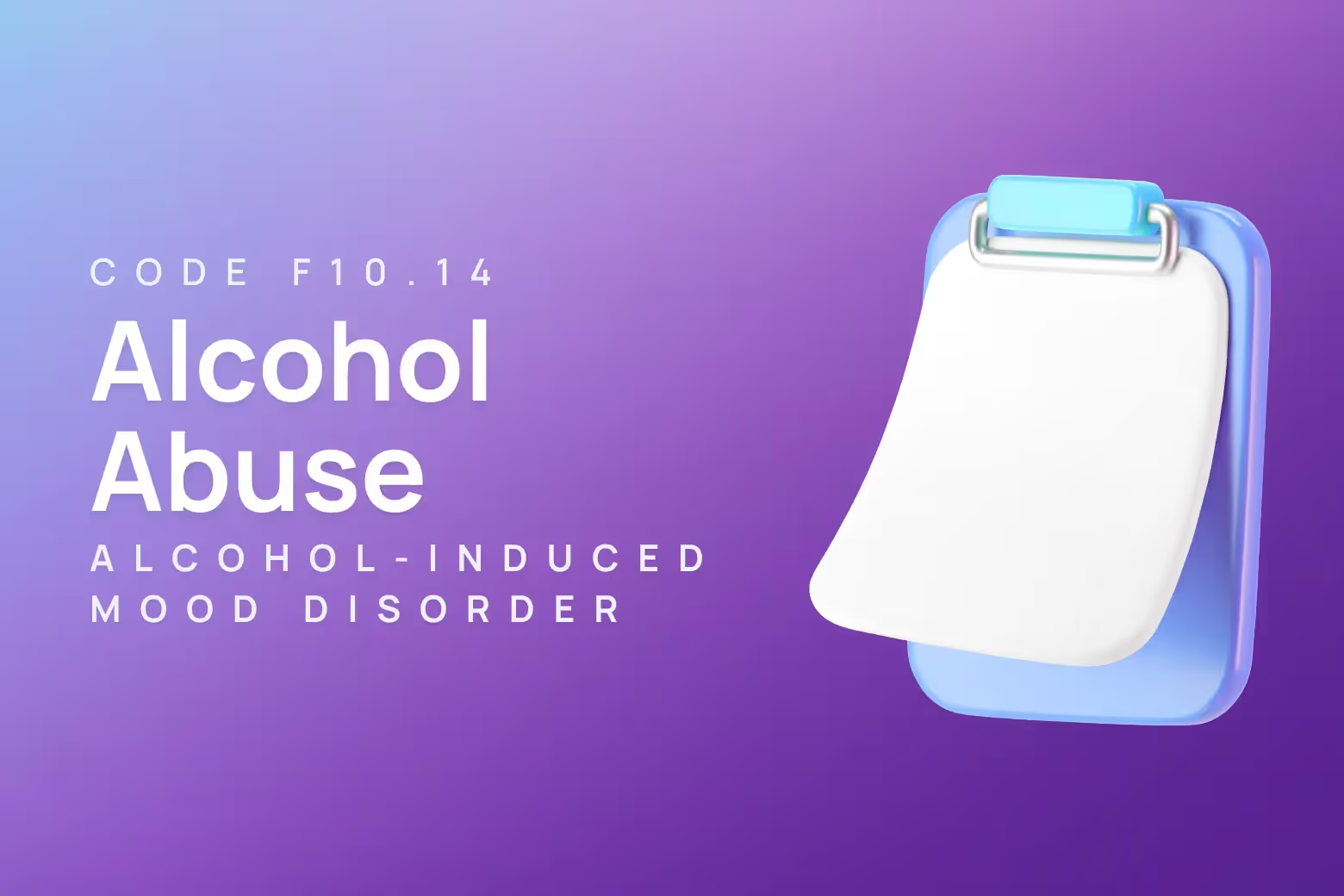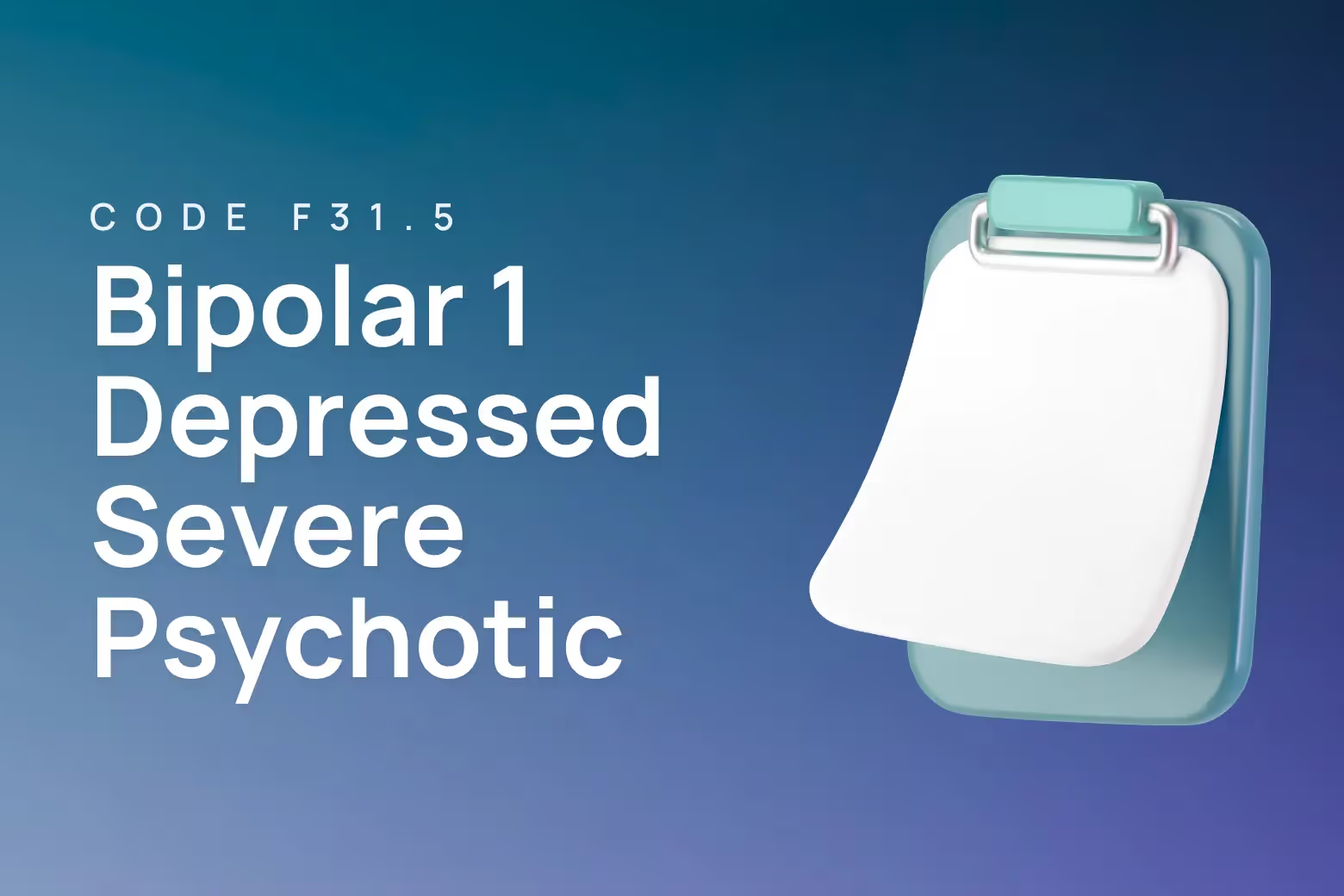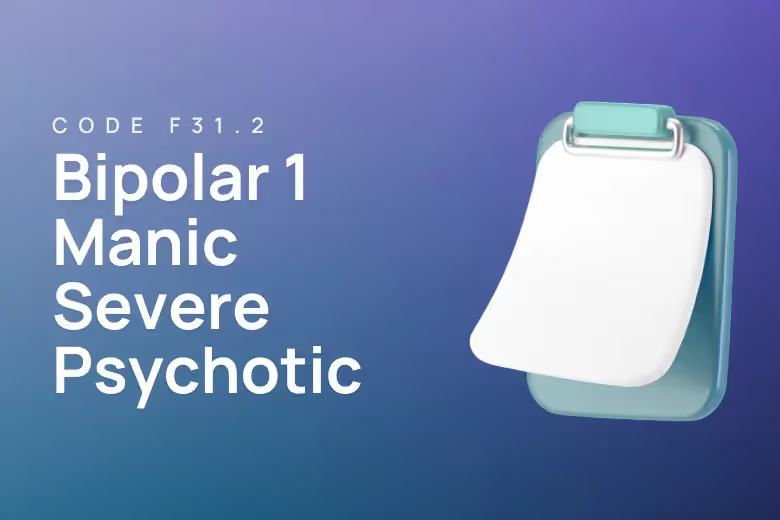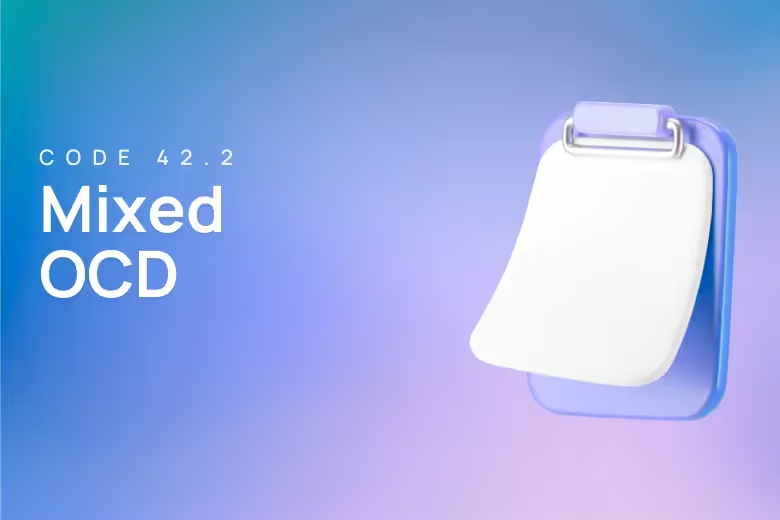ICD-10 code for alcohol abuse, with alcohol-induced mood disorder

F10.14 is the ICD-10 ode for alcohol abuse with alcohol-induced mood disorder.
This code captures a specific presentation where problematic alcohol use directly causes depressive or manic symptoms that wouldn't exist without the substance involvement.
Accurate diagnosis of this condition requires careful assessment to distinguish substance-induced mood changes from independent mood disorders, which fundamentally changes treatment planning and prognosis.
Key features:
- F10.14 identifies alcohol abuse patterns that directly trigger mood disturbances, requiring both abuse criteria and evidence of substance-induced mood symptoms
- Differential diagnosis centers on timing—mood symptoms must develop during or shortly after alcohol use and typically resolve within weeks of sustained abstinence
- Treatment combines substance abuse interventions with short-term mood stabilization, differing significantly from co-occurring independent mood disorders
- Proper coding affects treatment authorization, session planning, and helps clinicians track whether mood symptoms persist after addressing alcohol use

Diagnostic criteria for alcohol abuse with alcohol-induced mood disorder (F10.14)
The F10.14 diagnosis requires meeting two distinct clinical components that must occur together. Clinicians need to establish both a pattern of harmful alcohol use and evidence that this use directly causes mood disturbances.
The alcohol abuse component involves a problematic pattern of use leading to significant impairment or distress within a 12-month period.
This pattern includes continued drinking despite recurring social or interpersonal problems caused or worsened by alcohol effects, repeated failure to fulfill major obligations at work, school, or home due to alcohol use, recurrent drinking in physically hazardous situations, or continued use despite persistent legal problems related to alcohol.
The alcohol-induced mood disorder component requires clinically significant mood disturbance that developed during or within one month of alcohol intoxication or withdrawal.
These mood changes must cause marked distress or functional impairment and cannot be better explained by an independent mood disorder. Evidence that symptoms are substance-induced includes onset during active use or withdrawal, symptom severity exceeding what would be expected from alcohol's direct physiological effects alone, and substantial improvement within weeks of abstinence.
Diagnostic requirements include:
- Documented pattern of alcohol abuse meeting clinical criteria for harmful use
- Prominent and persistent depressed mood, markedly diminished interest or pleasure, or elevated/irritable mood
- Mood symptoms developed during or shortly after significant alcohol use or withdrawal
- Symptoms cause clinically significant distress or impairment in functioning
- Evidence from history, examination, or lab findings that mood disturbance is consequence of alcohol use
- Symptoms not better explained by independent mood disorder unrelated to substance use
- Mood changes persist beyond immediate intoxication or withdrawal but typically resolve with sustained abstinence
When to use F10.14 diagnosis code
Differential diagnosis for F10.14 requires careful attention to the temporal relationship between alcohol use and mood symptoms. The key clinical question centers on whether mood disturbances exist independently or emerge specifically as a consequence of substance use patterns.
F10.14 vs F10.24 (Alcohol dependence with alcohol-induced mood disorder)
The distinction between abuse and dependence fundamentally changes treatment intensity and prognosis. F10.14 applies when problematic use causes harm without physiological dependence features like tolerance or withdrawal.
F10.24 requires evidence of alcohol dependence including tolerance, withdrawal symptoms, drinking larger amounts or over longer periods than intended, unsuccessful efforts to cut down, significant time spent obtaining or recovering from alcohol, or continued use despite knowledge of physical or psychological problems caused by alcohol.
Dependent drinkers typically need more intensive intervention including possible medical detoxification.
Use F10.14 when abuse criteria are met without dependence features. The presence of mood symptoms doesn't automatically indicate dependence—the abuse versus dependence determination rests entirely on drinking patterns and physiological factors.
F10.14 vs F32.9 (Major depressive disorder, single episode, unspecified)
This differential represents one of the most challenging diagnostic decisions in behavioral healthcare. Independent depressive disorders require different treatment approaches and typically don't resolve with abstinence alone.
F32.9 applies when depressive symptoms existed before problematic alcohol use began, persist during extended periods of abstinence, or include features atypical for substance-induced presentations.
Family history of mood disorders, previous depressive episodes unrelated to substance use, or symptoms that worsen rather than improve with abstinence all suggest independent depression.
Use F10.14 when clear evidence shows mood symptoms emerged specifically during active drinking periods or withdrawal, when symptoms improve significantly within 2-4 weeks of abstinence, or when mood disturbances fluctuate directly with drinking patterns. The temporal relationship remains the most reliable diagnostic indicator.
F10.14 vs F31.32 (Bipolar disorder, current episode depressed, moderate)
Distinguishing substance-induced mood changes from bipolar disorder carries significant treatment implications, particularly regarding medication management and long-term prognosis. Misdiagnosis in either direction can lead to inappropriate interventions.
F31.32 requires documented history of manic or hypomanic episodes that occurred independent of substance use.
Bipolar disorder typically shows earlier age of onset, often includes family history of mood disorders, and persists regardless of substance use patterns.
Use F10.14 when mood disturbances—whether depressive or manic in presentation—occur exclusively during periods of heavy alcohol use or withdrawal without any documented independent mood episodes. Even if symptoms appear severe, substance-induced presentations typically resolve more quickly than independent bipolar episodes once abstinence is achieved.
Related ICD-10 codes
Understanding related diagnostic codes helps clinicians recognize the full spectrum of alcohol-related disorders and make appropriate diagnostic distinctions:
- F10.10 - Alcohol abuse, uncomplicated (no induced mood disorder)
- F10.11 - Alcohol abuse, in remission
- F10.12 - Alcohol abuse with intoxication
- F10.13 - Alcohol abuse with withdrawal
- F10.15 - Alcohol abuse with alcohol-induced psychotic disorder
- F10.20 - Alcohol dependence, uncomplicated
- F10.24 - Alcohol dependence with alcohol-induced mood disorder
- F10.94 - Alcohol use, unspecified with alcohol-induced mood disorder
Interventions and CPT codes for alcohol abuse with alcohol-induced mood disorder
Treatment for F10.14 requires integrated approaches addressing both substance use patterns and mood stabilization. The substance-induced nature of mood symptoms typically means they improve as drinking decreases, but concurrent support for mood regulation enhances outcomes.
Individual psychotherapy for alcohol-related mood disorders
Individual therapy forms the foundation of treatment, targeting both drinking behaviors and mood management strategies. Motivational interviewing helps clients resolve ambivalence about changing drinking patterns while cognitive-behavioral approaches address thoughts and behaviors maintaining both alcohol use and mood disturbances.
Sessions focus on identifying drinking triggers, developing alternative coping strategies, recognizing connections between alcohol use and mood symptoms, and building skills for managing cravings and emotional distress.
Treatment intensity should match abuse severity and mood symptom acuity.
Relevant CPT codes:
- 90791 - Psychiatric diagnostic evaluation (initial comprehensive assessment establishing diagnosis and treatment plan)
- 90832 - Psychotherapy, 30 minutes (brief check-ins or focused interventions)
- 90834 - Psychotherapy, 45 minutes (standard individual sessions combining MI and CBT-SUD approaches)
- 90837 - Psychotherapy, 60 minutes (intensive sessions for clients with significant mood symptoms or complex presentations)
Screening, brief intervention, and referral to treatment (SBIRT)
SBIRT approaches work particularly well for F10.14 presentations where abuse patterns haven't progressed to dependence. Brief interventions can effectively reduce drinking and monitor whether mood symptoms improve with decreased use.
Structured screening using validated instruments like the AUDIT or AUDIT-C establishes baseline severity and risk levels. Brief interventions incorporate feedback, responsibility, advice, menu of options, empathy, and self-efficacy (FRAMES model) to motivate change.
Relevant CPT codes:
- 99408 - Screening and brief intervention, 15-30 minutes (commercial payers)
- 99409 - Screening and brief intervention, greater than 30 minutes (commercial payers)
- G0396 - Structured assessment and brief intervention, 15-30 minutes (Medicare)
- G0397 - Structured assessment and brief intervention, greater than 30 minutes (Medicare)
- H0049 - Alcohol and drug screening (Medicaid)
- H0050 - Brief intervention per 15 minutes (Medicaid)
Group psychotherapy for substance use disorders
Group therapy provides peer support, reduces isolation, and offers cost-effective skill-building for managing both alcohol use and mood symptoms. Groups focused on relapse prevention help clients identify warning signs and develop concrete strategies for maintaining changes.
The group format allows clients to learn from others' experiences, practice new skills in supportive environments, and recognize that substance-induced mood disturbances commonly occur and improve with abstinence.
Relevant CPT codes:
- 90853 - Group psychotherapy (skills training, relapse prevention, peer support groups)
Family psychotherapy and systems interventions
Family involvement significantly improves outcomes for alcohol-related disorders. Sessions may address codependency patterns, improve communication, develop family support for abstinence, or help families understand the relationship between drinking and mood symptoms.
Family therapy helps educate loved ones about substance-induced mood disorders, reduces enabling behaviors, and strengthens the support system needed for sustained recovery.
Relevant CPT codes:
- 90846 - Family psychotherapy without patient present
- 90847 - Family psychotherapy with patient present
Crisis intervention for acute presentations
Some clients with F10.14 present in crisis, particularly during acute intoxication, withdrawal, or when mood symptoms create safety concerns. Crisis interventions address immediate risk while establishing plans for ongoing care.
Crisis work may involve safety planning, brief hospitalization coordination, or intensive outpatient stabilization depending on symptom severity and available support systems.
Relevant CPT codes:
- 90839 - Psychotherapy for crisis, first 60 minutes
- 90840 - Psychotherapy for crisis, each additional 30 minutes (add-on code)
How Upheal improves F10.14 ICD-10 documentation
Clinical documentation for alcohol-induced mood disorders requires careful attention to temporal relationships between substance use and mood symptoms. Upheal's clinical documentation platform helps therapists maintain detailed records that support accurate differential diagnosis while reducing time spent on administrative tasks.
Suggesting appropriate ICD-10 codes based on session content
Upheal analyzes session content to identify discussions of alcohol use patterns, mood symptoms, and their temporal relationships. The platform recognizes clinical language indicating substance-induced presentations—like clients describing mood improvements during brief abstinence periods or mood deterioration coinciding with increased drinking.
When session notes document drinking patterns meeting abuse criteria alongside mood disturbances emerging during active use, Upheal suggests F10.14 as a diagnostic consideration. This helps clinicians catch diagnostic nuances that might otherwise be missed in busy clinical practice.
The platform distinguishes between substance-induced and independent mood presentations by tracking symptom patterns across sessions, noting whether mood symptoms persist during documented abstinence periods or resolve as drinking decreases.
Maintaining HIPAA-compliant records with proper diagnostic coding
Documentation for F10.14 must clearly establish both abuse criteria and the substance-induced nature of mood symptoms. Upheal helps clinicians organize session notes to reflect this diagnostic complexity while maintaining compliance with privacy regulations.
The platform structures documentation to capture key diagnostic elements — drinking frequency and consequences, mood symptom onset and duration, periods of abstinence and corresponding mood changes, and functional impairment from both alcohol use and mood disturbances.
This organized approach ensures clinical records support the diagnosis if questioned by utilization reviewers while protecting sensitive information about substance use and mental health symptoms.
Reducing administrative burden so you can focus on client care
Therapists working with alcohol-related mood disorders face demanding documentation requirements — tracking drinking patterns, monitoring mood symptoms, assessing safety concerns, and demonstrating medical necessity for continued treatment.
Upheal automates much of this documentation work.
After each session, the platform generates comprehensive notes capturing discussions of alcohol use, mood changes, treatment interventions, and progress toward goals.
This frees clinicians to focus therapeutic attention on building rapport, delivering evidence-based interventions, and supporting clients through challenging behavior changes.
The time saved on documentation allows therapists to provide more responsive care, follow up more consistently between sessions, and maintain the clinical attention needed for effective treatment of complex presentations like F10.14.
Supporting clients with alcohol abuse and induced mood disorders
Clients with alcohol-induced mood disorders often feel confused and discouraged by their symptoms. Many assume they have independent depression requiring long-term medication when their mood disturbances may actually resolve with sustained abstinence and targeted support.
Psychoeducation about the relationship between alcohol and mood helps clients understand their experience and builds motivation for change.
Explaining that mood symptoms often improve significantly within weeks of reduced drinking provides hope while setting realistic expectations about the recovery timeline.
Treatment requires patience as clients navigate the discomfort of behavior change while managing mood symptoms.
Regular monitoring helps clinicians assess whether mood disturbances resolve as expected with decreased drinking or persist in ways suggesting additional diagnoses requiring different interventions.
Upheal supports this therapeutic work by streamlining documentation and freeing clinicians to focus on the clinical relationship. When therapists spend less time on administrative tasks, they can provide more attentive care during the critical early weeks when clients are most vulnerable to relapse.
Learn how Upheal can improve your clinical documentation and help you deliver more effective care at upheal.io/signup.













